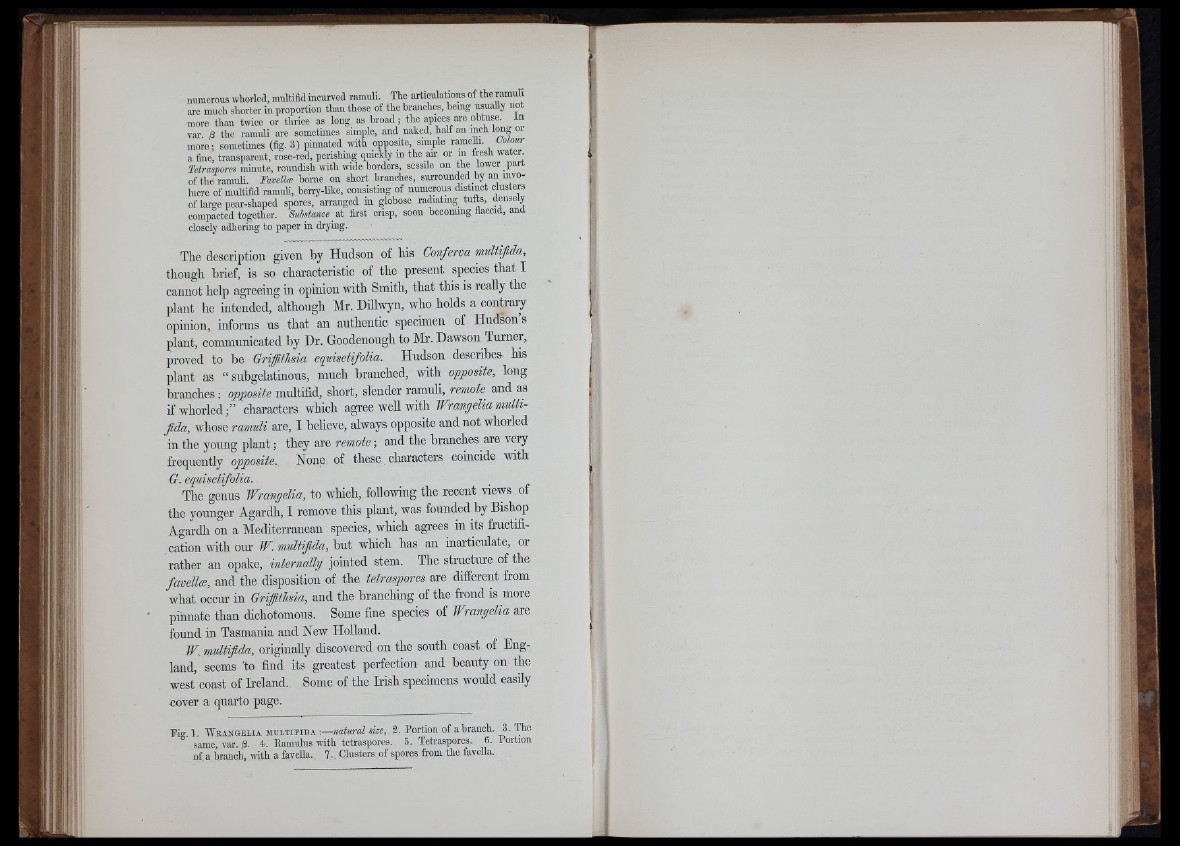
numerous whorled, multifid incurved ramuli. The articulations of the ramuli
ai-e inncli shorter m proportion than those of the branches, being usually not
more than tivice or thrice as long as broad ; the apices are obtuse. In
viu* B the ramuli are sometimes simple, and naked, half an inch long oi
more; sometimes (fig. 3) pinnated with opposite, simple ramcUi. toùour
a fine, transpai-ent, rose-red, perishing quickly in the au- or m fresh watei.
minute, roundish with wide borders, sessüe on the lower part
of the ramuli. Favellæ borne on short branches, surrounded by an involucre
of midtifid ramuU, beny-like, consisting of numerous distinct clusters
of lai-ge peai'-shaped spores, arranged in globose radiating tuits, densely
compacted together. Substance at fii'st crisp, soon becoming flaccid, and
closely adhering to paper in drying.
The description given by Hudson of his Conferva multifida,
though brief, is so characteristic of the present species that I
cannot help agreeing in opinion with Smith, that this is really the
plant he intended, although Mr. Dillwyn, who holds a contraiy
opinion, informs us that an authentic specimen of Hudson s
plant, communicated by Dr. Goodenough to Mr. Dawson Turner,
proved to be Griffitlma equisetifolia. Hudson describes his
plant as “ subgelatinons, much branched, with opposite, long
branches; opposite midtifid, short, slender ramidi, remote and as
if whorled;” characters which agree weU with Wrangelia multifida,
whose ramuli are, I believe, always opposite and not whorled
in the young plant ; they are remote ; and the branches are very
frequently opposite. None of these characters coincide with
G. equisetifolia.
The genus Wrangelia, to which, folloivfing the recent views of
the younger Agardh, I remove this plant, was founded by Bishop
Agardh on a Mediterranean species, which agrees in fis fructification
with our W. multifida, but which has an inarticulate, or
rather an opake, internally jointed stem. The structure of the
favellæ, and the disposition of the tetraspores are different from
what occur in Griffitlma, and the branching of the frond is more
pinnate than dichotomous. Some fine species of Wrangelia are
found in Tasmania and New Holland.
W. multifida, originally discovered on the south coast of England,
seems ’to find its greatest perfection and beauty on the
west coast of Ireland. Some of the Irish specimens would easily
cover a quarto page.
Fio- ] W r a n g e l ia m u l t if id a :— natural size, 2. Portion of a branch. 3. The
“ same, var. S- 4. Eamiüus with tetraspores. 5. Tetraspores. 6. Portion
of a bnmch, with a faveUa. 7. Clusters of spores from the favella.